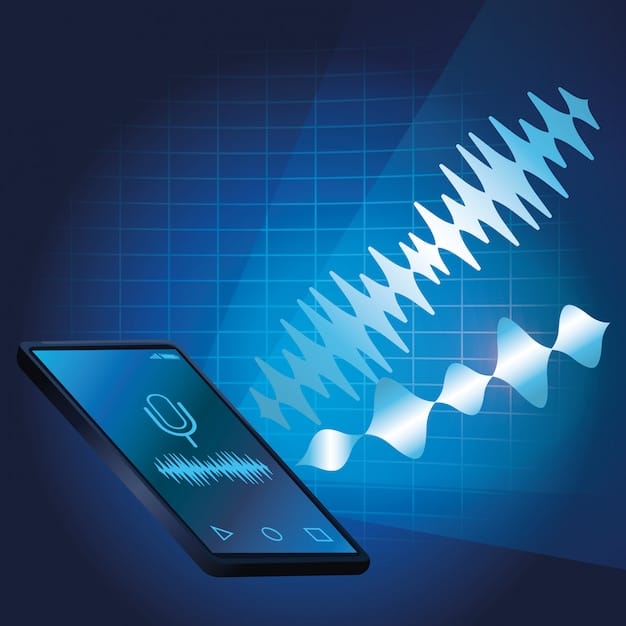Podcast Popularity Surge: Why Audio is Back in 2025

The podcasting landscape is set for a resurgence in 2025, driven by evolving listening habits, technological advancements, and a growing demand for personalized, on-demand audio content that caters to diverse interests and lifestyles.
Are you ready for the audio revolution? The podcast popularity surge: why audio content is making a comeback in 2025, might surprise you, reshaping how we consume information and entertainment.
The Resurgence of Audio: Setting the Stage for 2025
The audio landscape is evolving, and podcasts will experience a significant resurgence in popularity by 2025. Several factors, including changing consumption habits and technological advancements, are driving this comeback.
Let’s explore why audio content is poised to reclaim its throne in the digital realm:
Changing Consumption Habits
Consumers are increasingly seeking content that fits seamlessly into their busy lifestyles. Podcasts offer the perfect solution, allowing listeners to multitask while staying informed and entertained.
Technological Advancements
Innovations in audio technology, such as improved sound quality and seamless integration with smart devices, are enhancing the listening experience and making podcasts more accessible than ever before.

Here are some key trends fueling the podcasting comeback:
- Smart Speakers: The proliferation of smart speakers is making it easier to discover and listen to podcasts at home.
- In-Car Entertainment: Integration with car infotainment systems allows for seamless podcast listening during commutes.
- Wearable Devices: Smartwatches and other wearable devices provide on-the-go access to podcasts.
In summary, the resurgence of audio is driven by changing consumption habits and the latest tech. As people want to multitask, listen while they commute or work, and podcast technology now integrates seamlessly with many smart devices.
Personalization and On-Demand Content
One of the key drivers behind the podcast comeback is the increasing demand for personalized and on-demand content. Podcasts provide listeners with the ability to curate their own audio experience, selecting topics and formats that align with their individual interests and preferences.
This level of personalization sets podcasts apart from traditional media, making them a valuable source of information and entertainment for a diverse range of listeners.
Niche Content
Podcasts cater to a wide variety of niche interests, from true crime and history to self-improvement and business. This allows listeners to find content that is specifically tailored to their passions.
On-Demand Accessibility
Podcasts are available for on-demand listening, meaning listeners can tune in whenever and wherever they choose. This flexibility makes podcasts a convenient and accessible form of content.
Consider these approaches to personalization in the podcasting world:
- Interactive Podcasts: Engaging listeners through live Q&A sessions and polls.
- Customized Playlists: Offering curated playlists based on listener preferences and listening history.
- Personalized Recommendations: Utilizing algorithms to suggest podcasts that align with individual interests.
Ultimately, the appeal of personalization and on-demand content lies in the ability for listeners to shape their own audio experience. As listeners increasingly demand personalized content, the appeal of podcasts will only continue to increase.
The Role of Technology in the Podcast Renaissance
Technology plays a pivotal role in the resurgence of podcast popularity. Advancements in audio production, distribution, and consumption are making podcasts more accessible, engaging, and user-friendly.
From high-quality microphones to seamless streaming platforms, technology is empowering creators and listeners to connect in new and exciting ways.
Enhanced Audio Quality
Technological advancements have made it easier for creators to produce high-quality audio content. Improved microphones, editing software, and noise reduction tools are resulting in a more immersive listening experience.
Seamless Distribution
Podcast distribution platforms, such as Apple Podcasts, Spotify, and Google Podcasts, have made it easier for listeners to discover and access podcasts. These platforms offer user-friendly interfaces and powerful search capabilities.

Here’s how technology is transforming the podcasting world:
- AI-Powered Transcription: Automatic transcription services are making podcasts more accessible to people with hearing impairments.
- Spatial Audio: Immersive audio technologies are enhancing the listening experience, creating a more realistic and engaging soundscape.
- Interactive Audio Ads: Innovative ad formats are allowing listeners to interact with podcast advertisements in new ways.
In conclusion, technology is not just an enabler but a key driver. High-quality delivery and sophisticated distribution platforms make it easier for listeners and creators alike to connect. This is further supported by innovative technology such as AI transcription, spatial audio, and interactive audio ads.
Podcasting as a Marketing and Branding Tool
Podcasts are emerging as powerful marketing and branding tools for businesses and entrepreneurs. By creating and distributing audio content, brands can connect with their target audiences in a unique and engaging way.
Podcasts offer a valuable opportunity to build brand awareness, establish thought leadership, and drive customer engagement.
Building Brand Awareness
Creating a podcast allows brands to reach a wider audience and build brand awareness. By consistently producing high-quality content, brands can establish themselves as trusted sources of information and entertainment.
Establishing Thought Leadership
Podcasts provide a platform for brands to share their expertise and insights, establishing themselves as thought leaders in their respective industries. This can help to attract new customers and partners.
Consider these approaches to leverage podcasting for marketing and branding:
- Guest Appearances: Participating as a guest on relevant podcasts to reach new audiences.
- Sponsorship Opportunities: Sponsoring podcasts that align with brand values and target audiences.
- Cross-Promotion: Promoting podcasts on other marketing channels, such as social media and email newsletters.
To summarise, podcasting can be a brilliant marketing and branding tool which increases brand awareness and customer engagement. Being a guest or even sponsoring podcasts builds on a brand’s values and connects brands with their target audiences. Overall, it is a powerful tool for engaging with brands.
The Podcast-as-a-Service (PaaS) Model
The rise of the Podcast-as-a-Service (PaaS) model is transforming the podcasting landscape. PaaS solutions provide creators with a comprehensive suite of tools and services, making it easier to produce, distribute, and monetize their content.
From hosting and editing to marketing and analytics, PaaS platforms are streamlining the podcasting process and empowering creators to focus on what they do best: creating great audio content.
Streamlined Production
PaaS platforms offer a range of tools and services that streamline the podcast production process, including recording software, editing tools, and hosting services.
Monetization Opportunities
PaaS solutions provide creators with a variety of monetization options, such as advertising, subscriptions, and sponsorships. This allows creators to generate revenue from their podcasts and sustain their efforts.
Here are some benefits of using the Podcast-as-a-Service model:
- Cost-Effectiveness: PaaS solutions can be more affordable than piecing together individual tools and services.
- Scalability: PaaS platforms can scale to accommodate growing audiences and content libraries.
- Dedicated Support: PaaS providers offer dedicated support to help creators troubleshoot issues and optimize their podcasts.
To summarise, Podcast-as-a-Service (PaaS) is rising in popularity to help creators monetize content. This also streamlines the podcast production process, is scalable for accommodating users and offers dedicated support to help creators with the content.
Challenges and Opportunities in the Podcast Space
While the podcast space is ripe with opportunity, it also presents a number of challenges. Creators must overcome obstacles such as discoverability, monetization, and audience retention in order to succeed.
By addressing these challenges head-on and embracing new strategies and technologies, creators can unlock the full potential of the podcasting medium.
Discoverability
With millions of podcasts available, it can be difficult for creators to stand out from the crowd. Effective marketing and promotion strategies are essential for driving discoverability and attracting new listeners.
Monetization
Generating revenue from podcasts can be challenging, particularly for independent creators. Diversifying monetization streams and experimenting with new revenue models is key to long-term sustainability.
Consider these challenges and opportunities in the podcasting space:
- Audience Retention: Keeping listeners engaged and coming back for more requires consistently producing high-quality content and fostering a strong sense of community.
- Data Analytics: Leveraging data analytics to understand audience behavior and optimize content strategy is essential for maximizing impact.
- Collaboration: Partnering with other creators and brands can help to expand reach and cross-promote podcasts.
There are challenges for podcasters to overcome, from attracting new audiences and monetization issues to producing high-quality content that fosters a strong community. Podcasters must also leverage data analytics to understand the audience’s behaviour and maximize the impact of their content.
| Key Aspect | Brief Description |
|---|---|
| 🎧 Content Personalization | Listeners choose content aligning with their interests. |
| 📱Technological Advances | Improved audio, distribution via smart devices. |
| 💼 Marketing Tool | Brands build awareness, thought leadership. |
| 💰 Monetization | Podcast-as-a-Service, subscriptions, ads. |
FAQ
▼
Podcasts are increasingly popular because they offer personalized, on-demand content that fits into busy lifestyles. They provide an easy way to stay informed and entertained while multitasking.
▼
Technology enhancements, like smart devices and better audio gear, have made podcasts more accessible and of better quality. AI transcriptions and spatial audio improve the listening experience.
▼
Yes, podcasts are excellent for marketing and branding. They can build brand awareness, establish thought leadership, and drive customer engagement by providing unique and engaging content.
▼
Podcast-as-a-Service (PaaS) offers a comprehensive suite of tools that streamline podcast production, distribution, and monetization. This allows creators to focus on crafting great audio content more efficiently.
▼
Major challenges include ensuring discoverability, effectively monetizing content, and maintaining audience retention. Creators need to innovate and use data-driven strategies to overcome these obstacles.
Conclusion
The resurgence of podcasting in 2025 is fueled by personalized content, technological advancements, and strategic marketing applications. As creators address challenges and innovate, podcasts will continue to shape the future of audio content consumption.





